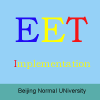-
Integrating technology with results
普通类 -
- 支持
- 批判
- 提问
- 解释
- 补充
- 删除
-
-
Integrating technology with results
MEANINGFUL INTEGRATION OF TECHNOLOGY will result in higher test scores. But where does one begin to obtain these results? Integration doesn’t just happen. Meaningful integration takes place when the teacher combines technology, textbooks, and the curriculum into one package. Schools invest thousands of dollars into textbooks, curriculum and technology. Too often the teacher is left to figure it out on their own. Yet the teacher is held accountable to obtain results in higher test scores. How can this enormous task be accomplished?
-
Aligning Three Essentials
We must look at the role of three essentials of school: the curriculum, the textbook and technology. The teacher integrates these three. Research and evaluation shows that technology can enable the development of critical thinking skills when used for presentation, publishing, sharing results of projects, and assessment. (CAST, 1996)
The teacher must work with curriculum, technology and textbooks to foster meaningful learning.
Higher test scores and deeper understanding of content domains result when curriculum standards are aligned with textbooks, teacher instruction, and available technology. Once the standards (content) have been established, the appropriate tools (textbooks and technology) can be determined by the teacher. Choosing the best tool for each student is important. A variety of options works best. This allows the learner to chose and take more ownership in their learning.-
Build a Website that Works
Creating a website is one way of integrating technology. Using websites eliminates the question of platform, eliminates the use of discs and viruses, enhances the textbook, involves technology and fosters accountability. A website model was presented at the Florida Technology Conference in 2001. Anecdotal research has shown this model to be effective. It has been most effective with students who miss numerous of days of school, yet continue to have contact with the instructor.
Follow the example of a U.S. History unit designed for an eighth grade class. The unit introductory page is designed for very simple and consistent navigation throughout the whole website. Each individual unit is designed with four basic functions: Knowing what the unit is about, what the student will learn, practicing what is learned and how learning is assessed. In this model, there are four key components to each unit: an Introduction, Readings, Activities, and a Rubric.
The Introduction briefs the learner regarding the
content of the unit.
The Readings provide the background to the content and
introduce new concepts or knowledge to be gained.
Activities are designed to reinforce what was learned
in the readings.
Within the Rubric is a description of what is expected
of the learner.
Above is an example of the Introduction page. Navigating the website is completed with the four elements on the left side of the page. The Readings section will introduce the new information. It is in the Activities section where many of the technology tools can be put to their best use. Technology tools should be used to build upon the Readings and challenge the student to develop higher level thinking skill. Research and evaluation show that technology can enable the development of critical thinking skills when learning is assessed using software tools for presentation, publishing, and sharing results of projects. A well-designed web page, simple and easy to navigate, will eliminate frustration on the part of the user.
-
Summary
When developing a website for students, one must make sure to identify curriculum standards. The curriculum standards are essential to measure the learning that takes place. Once the standards are identified, correlating textbooks and technology (the tools of education) are chosen to facilitate learning. Research shows that meaningful integration of technology into the classroom will result in greater knowledge gains and higher test scores. (Cradler, 2000)-
Author
David Navis , MA
EDTEC Graduate Student
Navis, D. (2005). Integrating technology with results. In B. Hoffman (Ed.), Encyclopedia of Educational Technology. -
-
- 标签:
- integrating
- unit
- website
- teacher
- readings
- student
- technology
- curriculum
- results
- textbooks
- tools
- designed
-
加入的知识群:



学习元评论 (0条)
聪明如你,不妨在这 发表你的看法与心得 ~